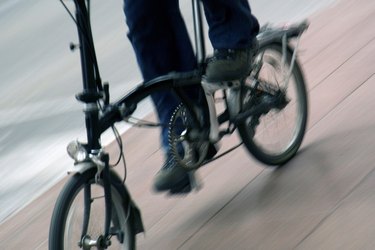
If you have been shopping for new bicycle tires you have likely encountered tires of the "folding" variety, which generally sell for $6 to $30 dollars more per tire than regular tires, as of late 2013. This increase in cost is the result of several differences in tire construction and cycling enthusiasts may find the superior features of folding tires to be worth the added cost.
Bead Materials
Video of the Day
The primary difference between the two tire types is the material used to construct the bead of the tire. The bead is the stiff, fabric-covered cord that forms the inner circumference of the tire and helps hold the tire onto the rim. With regular bicycle tires, the manufacturer constructs the bead using steel wire, which forms a stiff, durable bead. Folding tires instead use a synthetic fiber such as Kevlar, which is equally durable but more flexible.
Video of the Day
Flexibility
The flexibility of Kevlar is what gives folding bicycle tires their name. Unlike the stiff steel bead of a regular tire, you can easily fold a folding tire into a compact bundle. While this is certainly an advantage for packaging, manufacturers originally designed folding tires for long-distance touring cyclists who needed to take extra tires along with them on their trips. The folding tires were much easier to pack than regular bicycle tires.
Weight
Most cyclists do not engage in long-distance touring, but folding tires present another advantage that any cyclist can appreciate: they weigh less than regular tires. Reducing the weight of any component on your bicycle will improve your performance somewhat, but reducing the weight of the tires and wheels has a greater effect because of the energy required to keep them spinning. Using folding tires will generally save you about 2 ounces per tire, depending on the models under comparison.
Threads Per Inch
Because of their weight savings, manufacturers typically market folding tires as a premium product, and they often include other premium construction features along with the Kevlar bead. One of these features is a higher thread per inch, or TPI, count. The body of a bicycle tire is composed of nylon threads wound tightly together. A tire with a higher density of threads, and thus a higher TPI, has a suppler ride quality than a low TPI tire. Higher-quality tires usually have a TPI of 60 or greater. Regular bicycle tires are generally not available with high TPI counts.
Rubber Compound
Another premium feature manufacturers often include with folding tires is a softer rubber compound for the tire's tread. Although a softer tread will wear out sooner than a regular tread, it will provide better traction on most surfaces. To combat the more rapid wear, some tires utilize a dual-compound tread. Such tires feature a regular tread compound in the center of the tire, with a softer compound on the sides to aid traction while cornering. Manufacturers rarely offer regular tires with softer rubber.